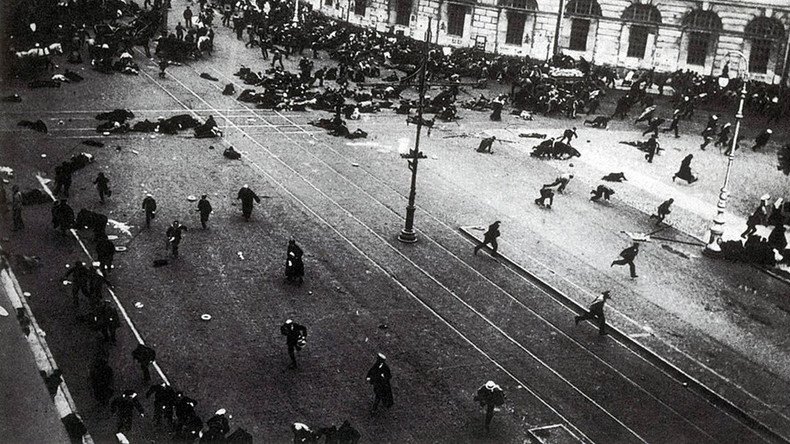#1917LIVE: 500,000-strong anti-govt rally turns violent in Russian capital, mass casualties reported

Weary of war and political crises, half a million soldiers and workers, led by the Bolsheviks, took to the streets of the Russian capital on July 17, 1917 to rise against the Provisional Government.
#1917LIVE is RT’s project resurrecting the events and protagonists of the Russian Revolution. Readers can join the reenactment on Twitter and adopt the character of their favorite historical figure, using the #1917CROWD hashtag. Help us bring to life the histories that culminated in the explosive October Revolution.
READ MORE: Female death battalions: Russian Wonder Women of 1917
The demonstrations started earlier on July 16,1917, when soldiers of the 1st Machine-gun Regiment, influenced by the anarchists, engaged in spontaneous armed protests. The unrest soon swept Petrograd (now Saint-Petersburg) with industrial workers joining in.
Whole Putilov factory (city's largest industrial facility) officially on strike, all 40,000 employees take part in demonstrations #1917LIVEpic.twitter.com/fnfvIXy1Ng
— Putilov Factory (@PutilovCo_1917) July 17, 2017
The July protests posed the biggest challenge so far for the liberal Provisional Government, which had been ruling Russia in tandem with the Soviets (workers and soldiers councils) since the monarchy was toppled in March, 1917.
The Bolshevik leadership, initially hesitant, eventually decided to lead the demonstration, insisting that it should be peaceful. Protesters, however, showed up armed.
HAPPENING NOW: Protest frenzy is back in #Petrograd with 100,000s people rallying against @ProvGovt_1917. Many protesters armed #1917LIVEpic.twitter.com/82FJfgQN1s
— Russian Telegraph (@RT_1917) July 17, 2017
On July 17, some 500,000 workers, soldiers, and sailors marched through central Petrograd under the slogan “All power to the Soviets.”
Hundreds of thousands march through central #Petrograd. Most banners about ousting @ProvGovt_1917 & transfer of powers to Soviet #1917LIVEpic.twitter.com/CJllCvBeVF
— Russian Telegraph (@RT_1917) July 17, 2017
Bolshevik leader Vladimir Lenin, who was out of town, promptly returned to the capital. He addressed the crowds calling for restraint, reassuring that the rule of Soviets will prevail.
Comrades! All we need to do is keep calm & have iron self-control to prevent ugly developments. All powers to Soviet will prevail #1917LIVE
— Vladimir Lenin (@VLenin_1917) July 17, 2017
The protest paralyzed the city.
MORE: All tram depots in #Petrograd on strike. City traffic practically brought to a standstill, streets packed with protesters #1917LIVEpic.twitter.com/6Iadi9TudG
— Russian Telegraph (@RT_1917) July 17, 2017
As the demonstrators were making their way to Taurida Palace, where the Provisional Government was seated, they came under machine gun fire. They responded by shooting in all directions. It was not clear who shot at them.
DEVELOPING: Multiple firefights in #Petrograd. Unclear who initiated gunfight. Unknown shooters & protesters exchanging rapid fire #1917LIVEpic.twitter.com/beJPvFVzox
— Russian Telegraph (@RT_1917) July 17, 2017
Clashes between protesters and forces loyal to the government and right-wing groups were playing out across the city. Authorities sent troops against the insurgents.
3K-strong force of Cossacks heading to #Petrograd from frontline, & this is only a small part of loyal troops we expect #1917LIVEpic.twitter.com/2UUvIYIgo2
— Provisional Govt (@ProvGovt_1917) July 17, 2017
Bolsheviks’ fellow Socialists, the Mensheviks and Socialist Revolutionaries, who were represented in the Provisional Government, did not approve of the mutiny and supported the crackdown against the protesters.
SRs & Mensheviks in @PetroSoviet1917 expect Bolshevik attempt to seize power! We need troops in #Petrograd ASAP! #1917LIVEhttps://t.co/S69SRokf1X
— Menshevik Tsereteli (@Mensheviks_1917) July 17, 2017
According to medical officials, 16 people were shot dead, 40 died in hospital of wounds, and some 650 were injured.
There were also students among the protesters. The youth of the time were swept away by intoxicating new ideas espoused by emerging left-wing politicians. Students, having no interest in their studies, occupied the rooms of their universities to hold endless political meetings.
This is it! The moment of truth! Comrades, forward! Today we will oust bourgeoisie from government! This is our revolution! 🔥 #1917LIVEhttps://t.co/2tvLSS5vFs
— Student Vladimir (@StudentVlad1917) July 17, 2017
The parties of the day quickly realized the potential force of the student movement – they were easily swayed, changed their opinions based on how good the present speaker spoke, were fearless and had no social liabilities – the perfect material for mass rallies.
RT introduced one such student into its interactive #1917LIVE project.
Meet Vladimir Khlebtsevitch, a math and physics student at the University of Petrograd.
I’ve joined the huge crowd that gathered in front of the @MKschessinska's Mansion. People say @VLenin_1917 will is speaking soon! #1917LIVEpic.twitter.com/3K9xaboNj7
— Student Vladimir (@StudentVlad1917) July 17, 2017
Like many of his peers, he was completely sucked into the revolutionary fervor sweeping through the capital of that era.
Unfortunately, he fell victim of the revolution. Khlebtsevitch was fatally shot during the mass rally.
URGENT: Popular blogger @StudentVlad1917 killed by a stray bullet on Liteyniy Prospect - unconfirmed report; we're verifying now #1917LIVEpic.twitter.com/jveEjdxarX
— Russian Telegraph (@RT_1917) July 17, 2017
Though the prototype of our Twitter character died a few months earlier during the February Revolution, he was a real student from the town of Syzran.
His body was transported to his parents, where a massive funeral was held to honor the young man’s revolutionary path. One of Syzran’s streets now bears his name.
RIP comrade @StudentVlad1917. They'll pay for your death with their own blood! #1917LIVEpic.twitter.com/hxcBnlU7M5
— Sailor Dybenko (@SailDybenko1917) July 17, 2017












